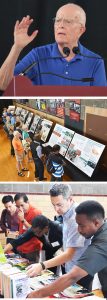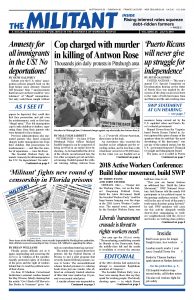OBERLIN, Ohio — “Deeper into the Working Class, Act on the Rulers’ Deepening Political Crisis, Build the Labor Movement, Build the Socialist Workers Party” read the large banner hanging over the stage at the 2018 Active Workers Conference. The annual event, sponsored by the Socialist Workers Party, was held here June 14-16.

“This year our banner features an additional line: ‘Build the Labor Movement,’” SWP National Secretary Jack Barnes told the nearly 400 participants in his political report to the opening conference session. “This will be the axis of work of the party’s trade union fractions going forward,” he said. SWP members will carry out this activity alongside weekly door-to-door campaigning in workers’ neighborhoods with the Militant and books on working-class politics, as well as participation in social and political struggles in the interests of working people.
That additional line on the banner wouldn’t have rung true last year, Barnes said, prior to the wave of teachers’ union battles since early 2018 that inspired workers across the country, won broad support and scored some victories. After decades of attacks on the working class by the employers, driven by the deepening crisis of their capitalist system, teachers and other workers are beginning to fight back. In the weeks before the conference, a number of participants across the U.S. and Canada had gone with co-workers and fellow trade unionists to bring solidarity to other labor actions and social protests. Through participation in such activity, the party is recruiting new members.
Ringing the hall, dozens of colorful displays illustrated the teachers’ strike battles, as well as other key political developments and questions in the U.S. and worldwide — from Korea to Europe to the Middle East. The exhibits showed experiences by members of the SWP and sister Communist Leagues in campaigning to advance a revolutionary working-class program and course of action.
The displays also addressed themes discussed in two other conference talks by SWP leaders — “Private Property, Women’s Oppression, and the Working-Class Road to Emancipation” presented by Mary-Alice Waters, and “The Proletarian Revolution and Culture” presented by Dave Prince — as well as classes and informal discussions over meals and elsewhere.
In addition to discussion sessions on the main presentations, there were classes on “Class Struggle, Communism, and the Jewish Question: from Palestine and Israel to Iran”; “Black Liberation and the Labor Movement”; and “The Political Legacy of the Grenada Revolution and Communist Leadership.”
Barnes placed the new openings in the labor movement in the U.S. in the context of important shifts in politics and the class struggle worldwide. He focused on recent developments on the Korean Peninsula, the ongoing wars and capitalist rivalries in the Middle East, the U.S. rulers’ relations with Moscow, and the accelerated tearing at the seams of the so-called G-7, European “Union,” and other imperialist pacts and crumbling “global” institutions.
This article focuses on these events and their significance for struggles by working people. Next week, in addition to continuing this account of U.S. and world politics, the Militant will report on other presentations, discussions and projections for party work at the SWP conference and subsequent National Committee meeting.
U.S. out of Korea!
The prospects opened by the Singapore summit between President Donald Trump and North Korean head of state Kim Jong Un, which concluded two days before the SWP gathering, are good for the working class, Barnes said — not just in the U.S. and Korea, but in Japan, China, and across the Pacific and the world.
The Socialist Workers Party has campaigned for decades to demand that the U.S. rulers get their troops, planes and bombs out of Korea and end their brutal imperialist sanctions against the people and government of North Korea. “Korea is one!” the SWP has explained, helping to educate working people in the U.S. and throughout the world about Washington’s bloody occupation and partition of Korea, with Moscow’s collusion, in 1945. With the victory of the Vietnamese Revolution in 1975 and unification of Germany in the 1990s, Korea remains the last nation on earth whose people were forcibly separated by the division of spoils at the end of the imperialist Second World War.
The SWP has long called for a halt to Washington’s annual joint military maneuvers with South Korea — accurately recognized by President Trump at the June summit both as “war games” and as “provocative,” to howls of protest by Democratic Party liberals and some Republican politicians. The U.S. government indefinitely suspended those war games with Seoul June 22.
Trump has also raised withdrawing some of the 28,500 U.S. troops stationed in South Korea — a proposal he first mooted during the 2016 elections — in exchange for the North Korean government taking steps to dismantle its nuclear missile program. The SWP calls, Barnes said, “For a Korean Peninsula, Japan and surrounding skies and waters free of nuclear weapons.”
Barnes drew attention to a chart given to all conference participants showing the nuclear arsenals of Washington (some 6,450 nuclear warheads) down to North Korea (an estimated 10 to 20). According to the chart, the most recent warhead tested by North Korea is 10 to 15 times more powerful than the U.S. bomb that annihilated some 100,000 or more people in Hiroshima in 1945 (including at least 20,000 Koreans, most of them forcibly transported as cheap labor for Korea’s Japanese colonial rulers).
The steps already taken by Washington since the Singapore summit “buy space and time for the working class,” Barnes explained, as will further steps in this direction. They have a welcome impact on working people in Japan, who have living memory of the U.S. rulers’ nuclear attacks on Hiroshima and Nagasaki and oppose nuclear weapons in Asia, whether in Korea or on Washington’s submarine fleet plying the Pacific.
War and class conflict in Mideast
The U.S. rulers, Barnes said, are also pressing to hammer out agreements in the Middle East, both with rival bourgeois governments across the region and with the rising capitalist rulers in Moscow, who have their own economic, political, and military interests there, especially in Syria.
The current White House, Barnes said, has ceased acting on the false premise, one that has guided the last several Democratic and Republican administrations alike, that “the U.S. rulers can dominate the world unopposed in the mistaken belief they won the Cold War.” While Washington maintains massive military superiority over other world powers, it can no longer simply impose U.S. capital’s will through bloody wars — wars that have now gone on, from Syria to Afghanistan, for more than 17 years. Instead, the current administration is seeking to advance U.S. imperialist interests by moving to end some longstanding conflicts and pull in its horns to a degree, at least for now.
This is Washington’s course, for example, in seeking a deal with the Israeli and Russian governments to end the now eight-year-long Syrian civil war and restore a semblance of stability to advance their separate but mutual class interests. Increasingly over that long and bloody conflict, the bourgeois clerical regime in Tehran has deployed its armed forces and associated militias across Syria — including the Lebanon-based organization and militia Hezbollah, which Iran’s rulers created and politically dominate — seeking to defend the tyranny of Bashar al-Assad and entrench the Iranian rulers’ position there. Their goal is to use this position to control a wide arc of territory and political/military influence to expand their counterrevolutionary sway across Iraq, Syria, and Lebanon to the Mediterranean and the borders of Turkey and Saudi Arabia.
Since 2015, both Moscow and Tehran-backed forces had succeeded in propping up the Assad regime. Together with military efforts by Kurdish-based military forces in northeast Syria, aided by Washington both in the air and on the ground, armed opposition groups in Syria, including Islamic State, have been pushed back. At the same time, those military victories have weakened the glue holding together Moscow’s and Tehran’s temporarily coinciding but conflicting class interests.
In recent months, Russian President Vladimir Putin has met with Israeli Prime Minister Benjamin Netanyahu and agreed that the Israeli rulers can strike at Tehran-backed forces — including not only Hezbollah, but Iranian troops themselves — when they get too close to Israel’s border or start stockpiling and transporting large quantities of missiles and other weapons. Washington, Tel Aviv and their Mideast allies are all pressing — both separately and, to the degree they can, together — to end Tehran’s military presence in Syria.
The Israeli government’s June 18 airstrikes killed and wounded dozens of the Tehran-backed Shiite Kata’ib Hezbollah militia members in Syria, with no response from Moscow. A similar airstrike in May, directly destroying Iranian forces — again with no military response by Moscow — was carried out by the Israeli government while Netanyahu was on a return flight from a visit to Putin in Russia.
In return for its silence on the Israeli government’s airstrikes, Barnes said, Moscow seeks talks with Washington to guarantee the expansion of the Russian military base at the warm-water Syrian port of Tartus, key to Russia’s navy, and its nearby air force facilities. Days after the SWP conference U.S. National Security Adviser John Bolton was dispatched to Moscow to prepare the ground for a summit between Trump and Putin (jointly announced for later this summer by the two governments as this issue was going to press).
The Iranian ruling class acts against the toilers of Iran, and its foreign policy is an extension of that counterrevolutionary course at home, Barnes said. But the rulers in Tehran “are neither suicidal, nor irrational. They, too, can be pushed to seek a new deal with Washington, and, if that is successful, with Tel Aviv.”
Washington also sent President Trump’s son-in-law and White House Adviser Jared Kushner to Israel, Saudi Arabia, and Egypt in late June to discuss the next stages in advancing its Mideast peace plan, Barnes said.
Despite the U.S. rulers’ intentions, these moves — from Korea to Moscow to the Middle East — can have positive results for the working class and toilers, helping to open much-needed political space to organize; to gain class-struggle experience against their respective capitalist ruling classes; to strengthen ties of workers solidarity across imperialist-stoked national and religious divisions; and to take steps toward the building of new working-class leadership.
Next week, the myth of the so-called G-7 and European “Union”; “trade war”; U.S. liberals, the “Resistance,” and a working-class course in face of assaults on the rights of working people, women, Blacks, and immigrants; and much more from the SWP’s 2018 Active Workers Conference.


